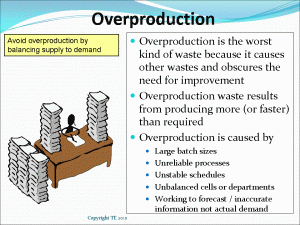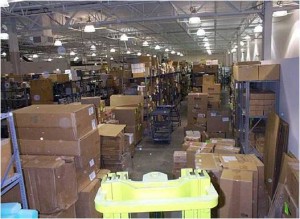The Waste of Overproduction
Overproduction is the worst of the seven wastes of lean manufacturing (7 Mudas), overproduction is making products in too great a quantity or before it is actually needed leading to excessive inventory. Overproduction is the worst of the seven wastes as it obscures all of the other problems within your processes.
The principles of Lean Manufacturing require you to make what the customer wants when they want it, pulling only what is ordered through your work flow. Just In Time manufacturing is possible in any industry with ingenuity and improving technology.
Costs of the waste of Overproduction
Overproducing causes you to tie up your capital in stock, raw materials, work in progress (WIP) and finished goods. Your cash is what you rely upon to run your business, so you either leave yourself short or you end up paying charges to your bank. Many businesses have failed because they cannot buy raw materials to service a customer because they have already put their cash into materials that are not required.
Another cost associated with Overproduction is to do with the storage and movement of the inventory that you have created, it all requires space, it needs people and equipment to move it around and it needs containers for storage. All of this is a cost to you, if you could eliminate it the savings would be straight back on your bottom line improving your profit.
Causes of the Waste of Overproduction.
Why do we overproduce? Often the answer is as simple as because “this is how we have always done it!” I have over the years been into many companies that run huge batches of material creating enormous amounts of stock where they could easily reduce the batches and improve their flow reducing lead times and improving customer service. (I will relate a case study below to highlight this.)
We produce large batches because of long setups on some of our machines, so we try to maximize our throughput of these machines and use “economical batch quantities” to dictate how much material is processed rather than what the customer wants.
We also distrust our suppliers ability to supply what we need, so we order more than we need and sooner than we need it to ensure that we have it when we need it, this additional stress that we place on our suppliers often causes them to fail becoming a self fulfilling prophecy.
We also distrust the reliability of our own processes and plan to allow for interruptions in the flow of production, often scheduling a few days or even weeks between successive operations just in case of issues or the need to change the production plan. We plan in many of our delays and inventory and many ERP and MRP systems add to this problem.
We also work to forecasts; we guess what the customer will want in the future and invariably make mistakes and thus build product that is unwanted and don’t build what the customers really want.
Examples of wastes of Overproduction
I am going to relay a short case study regarding the waste of overproduction and inventory to highlight what many companies are guilty of; I went to a factory in the UK several years back to discuss a request for government grant money.
The owner of the factory was after a fairly small grant to purchase a machine to speed up his production capabilities, however the government was not giving out money at the time for these uses but it was suggested that I might be able to find ways to help him to free up cash within his business.
It was a family run business producing boxed games, art sets and similar products for direct shipment to toy shops and wholesalers across the UK and Europe. The owner had been the CEO for I think approaching 50 years; the business being around 150 years old!
I walked around the business and took some rough times of what people were doing within the business to be able to do some rough models to demonstrate what I thought were some pretty obvious issues to the owner.
The factory was split into two roughly equal parts, one a production hall and the other a warehouse, both employed almost equal amounts of people. The products were assembled in the production hall in small efficient little cells, but made in large batches to be stored in the warehouse. The warehouse then took each customer order and teams of store people would roam the warehouse to pick the orders, pack, and ship them.
It was clear that it actually took the stores people far longer to actually find and retrieve the products than the production people took to make them! Sometimes stocks were lost and had to be made anew, being found at a later date hidden behind other products.
The company held over a full year of production in finished goods stock, as well as raw materials the value of which I could not get. They wrote off 5% or more of this stock each and every year as games became obsolete, the products just being sent to landfill.
The grant that was required was less than one tenth of a percent of this stock. The business had made a loss for three years running and was threatened with closure.
I showed him how the business could be run with next to no finished goods, how he could move to smaller premises (His factory was fully owned in a prime city center residential area), how he could expand his production into new areas using the surplus staff and so on! However he repeatedly stated that his company could not function without stock!
I bought in several other visitors to visit this company to persuade the owner, got all of his management on our side, but still he failed to change and the company was closed by the banks almost a year later with no improvements! All because he did not believe that his business could be run without stock.
This is an extreme case with regard to the inability and reluctance to change, however the overproducing product for stock is not unusual and I see it in almost every company that I visit and still do! All because “this is the way that we have always done it!” But we are no longer in the days of the model T Ford, we need to be quick and we need to be flexible with our organizations to produce what the customers want when they want it!
The other causes of overproduction are to do with producing large batches of material in excess (or in advance) of customer orders because the setup times of our machines are excessive, this causes us to run “economic bath quantities” through the machines to maximize our utilization of these machines.
We also overproduce to allow for failure of unreliable processes, machines and even suppliers; producing more than we require just in case of failure. The excess inventory produced then allows us to continue production even if we have failures.
How to eliminate or reduce Overproduction
The first step is to realize that we are doing it; understand that we are often planning our own delays and large batches just because we always have done so. Many planning packages such as ERP and MRP amplify these problems; I have often (in fact on reflection in every case) switched off the planning modules on these software packages in every company that I have been to with lead time and delivery issues.
Once we understand the issues we need to implement the principles of lean manufacturing, identify the value stream using tools such a value stream mapping, process mapping, spaghetti diagrams and a host of analytical tools that are available to us. Then we need to make that value flow by rearranging our work place, creating production cells that contain all of the required processes and moving away from functional layouts. Using smaller, simpler, dedicated machines rather than “super machines” that have to handle every product in the factory.
We need to tackle set up times on our equipment to enable the production of smaller batches using the technique of SMED, Single Minute Exchange of Die.
Once we have done this we can use the ideas of just in time manufacturing to enable the production of product only when it is ordered, using techniques such as Kanban to enable the Pull of production through our processes.
In doing this we not only eliminate the overproduction in our processes but we begin to eliminate and highlight the causes of many other problems within our processes that are hidden by all of this inventory.
Waste Reduction to Improve Business Profits
By eliminating or reducing the Muda, Muri and Mura within our processes we are able to realize the benefits of lean manufacturing; benefits that will causes our costs to be reduced significantly and increase our products in tandem. By implementing the principles of lean manufacturing we look to Just in Time (JIT) production, only making what the customer wants when they want it thus reducing overproduction, we also need to reduce or eliminate the other wastes;
The waste of inventory; all of the materials, work in progress (WIP) and stock held in the company.
The waste of Transport; transportation from one area to another.
The waste of waiting; waiting for work or information.
The waste of Motion; the excessive movement of man or machine.
The waste of Overprocessing; doing more than the customer has asked for.
The waste of Defects; parts or services that do not meet customer requirements.
The waste of Resources; wasting electricity, gas, water and any other resources you rely on.
The waste of talent; not respecting and involving your employees in your business.



hi
how do I calculate the cost of overproduction
do have any formula for it
Hi Abdul,
There is no simple formula for calculating the cost of overproduction and it will very much depend on the industry that you are in. Overproduction can create costs in many areas from interest paid on the cost of excess stock that you are holding, storage costs, missed opportunity costs, through to potential disposal costs of unsold goods. All you can do is consider all of the potential areas that it will impact in your business and try to assign a cost to them.
But I would ask yourself why are you trying to assign a cost? What are you trying to achieve by assigning a cost to it? If its purpose is to convince others to take action then you should only use clear and defined costs as using anything that may be disputed can provide people with an excuse to take the easy route and do nothing.
it is normally measured against the plan of production.
for example if the plan is to produce 2 tons, but 3 tons are produce, then there is 50% over-production